
Management for Control
Management has always been important to coccidiosis control, especially before drugs were available. Management focuses on reducing the number of coccidia to keep infection at a minimum until immunity is established.
Natural Immunity
A small-scale, low-density production system can allow a low level of exposure to coccidia, which permits the chick to develop immunity without triggering the disease. However, birds may not pick up enough parasites to cause immunity, or they may be overwhelmed by too many. In addition, immunity is only species-specific. Exposure to one type of coccidia will not protect a chicken from the other six types that can infect it.
Early detection is a management method to avoid the use of preventative medication. If you can catch the disease when it initially infects only a few birds, you may have time to treat the birds with a rescue drug or make a management change, such as moving the birds to fresh pasture. Early detection requires close observation and experience. Watch feed intake in particular – it goes down in the early stages of coccidiosis.
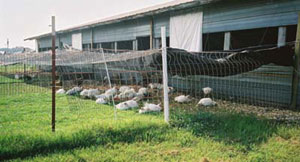 |
| Small poultry producers often provide outdoor access. |
The choice of production system is an important management decision. High-density, large-scale production almost always requires the use of anticoccidial medication. In contrast, in low-density, small-scale production, the birds tend to stay ahead of the parasites and may not require medication. Many small-scale producers do not use anticoccidial medication; however, as the size of the flocks grows, more problems are encountered and more management is required for natural immunity.
Small poultry producers often provide outdoor access with either a permanent house and yard or portable houses. Small pens that are moved daily are also used.
These small growers usually brood chicks in a separate area before moving them to the outdoor facility for growout. However, some growers brood chickens in the same house in which they are grown.
See ATTRA’s Sustainable Poultry: Production Overview for more information on small production systems.
Immunity is especially important in turkeys, layers, breeders, and slow-growing broilers that are kept longer than fast-growing broilers marketed at a younger age.
|
|
Brooder and Growout Management
When chicks are brooded in a separate area before moving them to the growout facility (two-stage production), the brooder stays clean of infective oocysts since fast-growing broilers do not remain past three weeks of age. However, chicks are at risk for coccidiosis if they stay in the brooder longer than three weeks. Pullet chicks for egg laying grow slowly and stay in the brooder longer. If chicks are brooded and grown out in the same facility (one-stage production), they seed the area with coccidia. These birds may require a lower density or, possibly, medication. The following management strategies for good brooding can help.
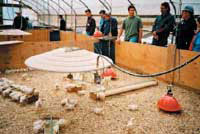 |
| The chicks are kept in this brooder for only a few weeks and later moved to a growout pen or small house. |
Good brooding practices can reduce the need for medication and include not only sufficient space but also sanitation and litter management. Give birds adequate floor space and feeder/waterer space to prevent overcrowding. Small flock producer Robert Plamondon recommends at least one square foot of floor space per chick and four tube feeders per 100 chicks. (Plamondon, 2003)
Keep the feeders full. If feeders go empty, birds forage in the litter and ingest oocysts. The longer they peck at contaminated litter, the more oocysts they will ingest.
Sanitation
Disinfectants are not effective against coccidia, so sanitation focuses on good hygiene and removing infected droppings.
- Put waterers and feeders at a height level with the backs of the birds, so they cannot defecate or scratch litter into them. Keep birds from roosting on the feeders with anti-roosting wire. Suspend waterers or put them on wire-covered platforms to help keep them clean.
- Clean the waterers and feeders frequently.
- Keep older birds away from chicks, since old birds are carriers.
- Add fresh litter or rake litter frequently to cover parasites.
Litter Management
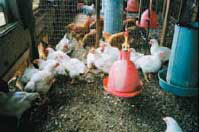 |
| Keep litter dry by preventing water spills. |
Keep the litter dry to reduce sporulation of oocysts. Remove any wet or crusted litter. Moisture in the litter is affected by the following:
- Heat source: A propane radiant brooder heats a larger area and dries out litter more than a heat lamp.
- Ventilation: Housing should prevent drafts but not be airtight. Humidity, along with ammonia and other gases, needs to escape.
- Water leaks: Water leaks must be prevented.
- Condensation: Condensation may occur in buildings with uninsulated roofs and walls and will contribute to litter moisture.
- Feed: Rations with excessive protein or excessive salt can result in wet litter.
In the large-scale industry, “new-house coccidiosis syndrome” sometimes occurs when birds are placed on brand-new litter. There is no low-level population of coccidia to establish immunity, so the flock is more susceptible, coccidiosis problems are more likely, and medication may be needed.
Some small flock producers are interested in the built-up or composting litter as an ecosystem of microbes.
Plamondon recommends starting with at least six inches of shavings and adding a thin layer of fresh litter on top, which will prevent chicks from eating old litter at first. He turns it daily with a spading fork to keep it from getting packed down and crusted over. If the litter seems too wet, he adds more dry litter. He only removes litter when it is too deep to manage or when too wet. (Plamondon, 2002b)
Also, although oocysts can be destroyed by microbes in the litter and soil, there may be so many oocysts that the birds become infected. Unfortunately, there is little scientific information available on composting litter.
Pasture
Producers provide outdoor access to allow poultry to express natural behavior, increase space, and to provide fresh air and sunlight. Outside, birds may pick up fewer oocysts, since they are more likely to peck forage instead of droppings; however, access to the outdoors has both advantages and disadvantages for coccidial control. Extreme heat and cold outdoors can reduce sporulation or kill oocysts. Yet warmth and moisture are favorable conditions for coccidia. Before the use of medication, commercial producers used to experience coccidiosis outbreaks in late spring, summer, and early fall.
In the warm, humid South, coccidiosis is a greater problem than in dry western states. Dry conditions on pasture greatly reduce coccidiosis. In cold areas, although oocysts on pasture may die during winter, the chickens in the house during winter still carry oocysts and reseed the pasture with them in the spring.
It is important to control areas of high traffic outdoors to reduce the number of oocysts. The locations of the waterers and feeders, the pasture, and the house itself, if possible, should be rotated. Straw, litter, or bark can help control muddy areas. Controlling coccidiosis on pasture is trickier with broilers than with layers, since the broilers are faster-growing and less active. They eat a lot, generating large amounts of manure, and congregate in shaded areas. Layers get off the ground to roost on perches. Keeping birds in a floorless pen that is moved daily eliminates coccidiosis by breaking the life cycle – oocysts cannot re-infect birds.
Copyright © NCAT 1997-2007. All Rights Reserved.


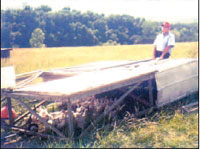
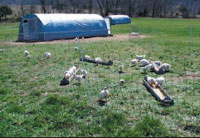
 © 2000 - 2021. Global Ag MediaNinguna parte de este sitio puede ser reproducida sin previa autorización.
© 2000 - 2021. Global Ag MediaNinguna parte de este sitio puede ser reproducida sin previa autorización.